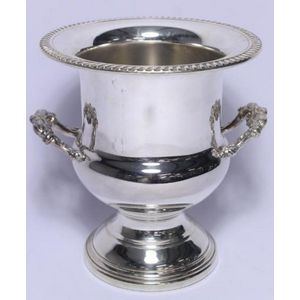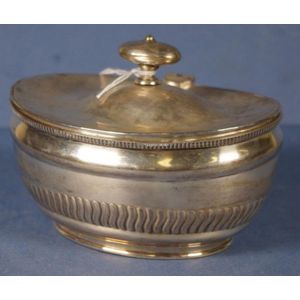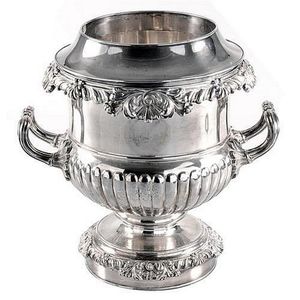George IV Sheffield Plate Krater Wine Cooler
You must be a subscriber, and be logged in to view price and dealer details.
Subscribe Now to view actual auction price for this item
When you subscribe, you have the option of setting the currency in which to display prices to $Au, $US, $NZ or Stg.
- Krater - A Greek krater is a large vessel that was used in ancient Greece for mixing wine and water. The word "krater" comes from the Greek word "kraino," which means "to mix." In ancient Greece it was considered bad form to drink undiluted wine.
Kraters were used in symposia, or Greek drinking parties, where they were placed in the centre of the room and used to mix wine with water. The mixture was then poured into individual cups and served to the guests.
Kraters were often elaborately decorated with scenes from mythology or daily life, and could be made from a variety of materials, including ceramic, bronze, and marble.
There were several different types of kraters in ancient Greece, and they can be grouped according to the shape of the two handles, or of the vessel itself:- A Volute krater has handles shaped like the volutes on an Ionic capital, whereas a column krater has columnar handles.
- A calyx krater is shaped flower bud, while a bell krater is shaped like a bell.
- George Iv - George IV (1762 ? 1830) was king of the United Kingdom of Great Britain and Ireland and king of Hanover from 1820, until his own death in 1830. From 1811 until his accession in 1820, he served as Prince Regent during his father's final mental illness.
In English furniture design, his reign from 1811 to 1830 is known as the Regency period. - Sheffield Plate - Sheffield plate was the first commercially viable method of plating metal with silver. The method of plating was invented by Thomas Boulsover, a Sheffield Cutler, in 1743 and involved sandwiching an ingot of copper between two plates of silver, tightly binding it with wire, heating it in a furnace and then milling it out in to sheet, from which objects could be made.
Originally used by its inventor to make buttons, the potential of the material was quickly realised, and soon it was being used to fashion boxes, salvers and jugs, and not long after that candlesticks and coffee pots, and other traditional tableware.
Although there was a considerable saving in the amount of silver used, Old Sheffield Plate manufacture was more labour intensive than solid silver, meaning higher labour costs. This meant that Old Sheffield Plate was very much a luxury product, and only available to the very wealthy.
The thickness of the silver means that many 18th century Sheffield Plate pieces still have a good layer of silver, while electroplated pieces (EPNS), may have been replated several times over their lifetime. Where the silver has worn off the Sheffield plate the soft glow of the copper base can be seen underneath. However this is not an infallible guide that the piece is Sheffield Plate, as many EPNS items were also plated on to a copper base.
Most Sheffield plate items are unmarked, whereas most elecroplated items display manufacturers names or marks, quality indications such as "A1", "EP", together with pattern or model numbers.
Sheffield plate was made commercially between 1750 and 1850.
This item has been included into following indexes:
Visually similar items

A sterling silver rose bowl or monteith, 1900 London, with partial maker's mark C.S, the large waisted bowl with a scalloped edge raised on a stepped circular foot, embossed to the body with a spiral rib, scroll and foliate motif, the foot conforming, with

A baluster form silver-plate ice bucket. Height 25 cm

A cloisonne enamel censer Qing dynasty, 18th century of squat globular form supported on a splayed foot and set on the shoulders with double gilt elephant head handles below the flared mouth with raised gilt rim, the sides decorated with a continuous lotus

Georgian style silver plate lidded bowl, reeded decoration. No marks evident. Height 11 cm
